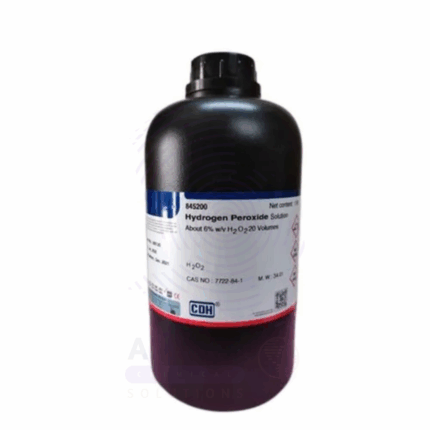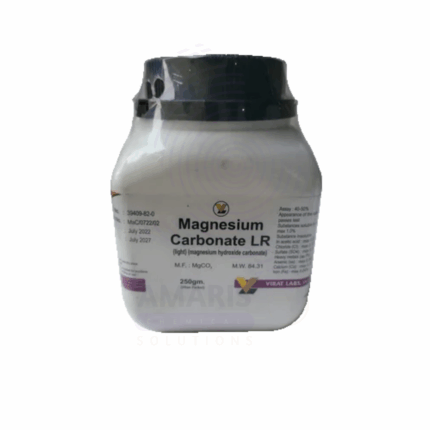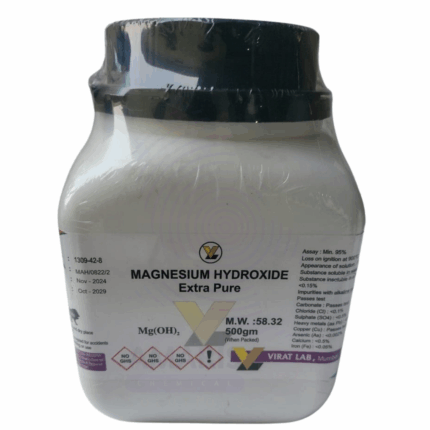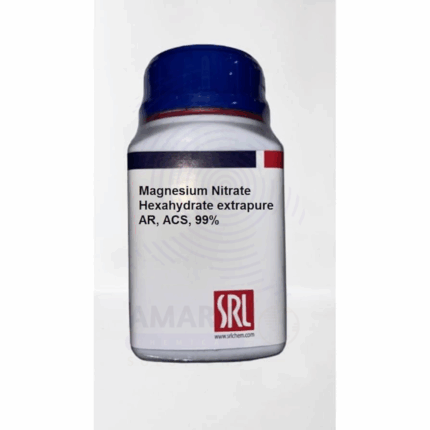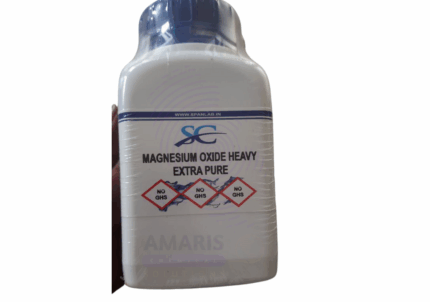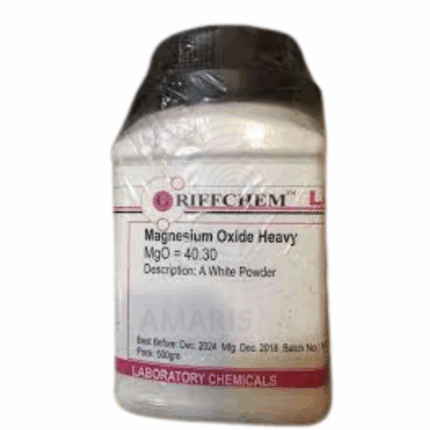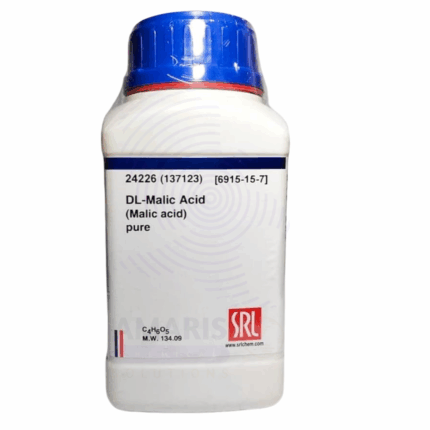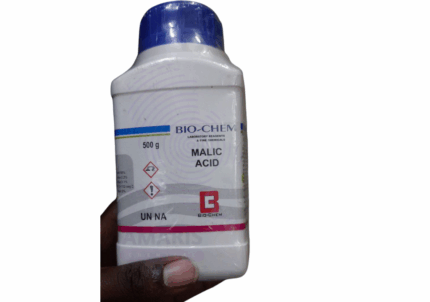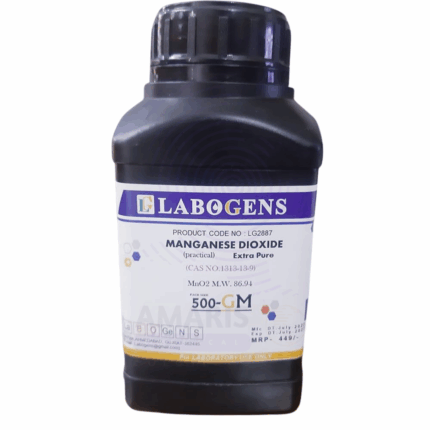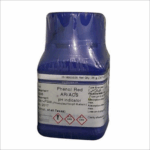
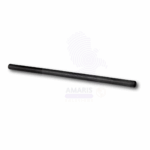
Phenol Detached Crystals Extra Pure
$ 17.20
Phenol Detached Crystals Extra Pure is a high-purity form of phenol, presented as colorless to white crystalline solids with a distinct, sharp odor. Known chemically as hydroxybenzene, phenol is both a weak acid and an effective antiseptic, offering versatile utility across laboratory, pharmaceutical, and industrial settings.
This Extra Pure grade is ideal for analytical chemistry, microbiological applications, and organic synthesis, especially in the production of resins, dyes, and plasticizers. It is also used in limited concentrations in medical preparations for its disinfectant properties. Phenol is highly corrosive and toxic upon contact or inhalation, requiring strict adherence to safety precautions, including the use of gloves, goggles, and fume hoods. It should be stored in tightly closed, light-resistant containers in cool, dry areas away from oxidizing agents.
Phenol Detached Crystals Extra Pure
PRIMARY USES
- Used as a disinfectant and antiseptic in laboratories and healthcare settings.
- Employed in chemical synthesis as a precursor to plastics (e.g., Bakelite), resins, and pharmaceuticals.
- Functions as a standard reagent in analytical chemistry and qualitative organic analysis.
- Used in DNA extraction protocols to denature proteins and purify nucleic acids.
- Applied in veterinary medicine for wound care and treatment of skin infections.
SECONDARY USES
- Utilized in cosmetic formulations (under controlled conditions) such as chemical peels and exfoliants.
- Acts as an intermediate in the production of dyes, detergents, and herbicides.
- Occasionally used in educational labs to demonstrate properties of weak acids and aromatic compounds.
- Incorporated in the manufacture of aspirin (acetylsalicylic acid) as a starting material.
- Historically used in embalming and preservation, though largely replaced by safer alternatives.
1. Basic Identification Attributes
- Chemical Name: Phenol
- CAS Number: 108-95-2
- HS Code: 2907.11.00
- Molecular Formula: C₆H₆O
- Synonyms:
- Carbolic acid
- Hydroxybenzene
- Benzenol
- Phenylic acid
2. Physical & Chemical Properties
- Physical State: Solid (detached crystals)
- Color & Odor: White to light pink crystalline solid with a distinct, sweet, tar-like odor
- Boiling Point: ~181.7 °C
- Melting Point: ~40.5 °C
- Density: ~1.07 g/cm³ at 20 °C
- Solubility:
- Moderately soluble in water (8.3 g/100 mL at 20 °C)
- Miscible with alcohol, ether, acetone, chloroform
- pH Level: Weakly acidic in solution
- Vapor Pressure: ~0.4 mmHg at 25 °C
- Flash Point: ~79 °C (closed cup)
- Autoignition Temperature: ~715 °C
- Viscosity: Low when melted
3. Safety & Hazard Attributes
- Hazard Class (GHS Classification):
- Acute Toxicity (Oral, Dermal, Inhalation) – H301, H311, H331
- Skin Corrosion – H314
- Specific Target Organ Toxicity (Repeated Exposure) – H373
- NFPA Ratings:
- Health: 4
- Flammability: 2
- Reactivity: 0
- Exposure Limits:
- OSHA PEL: 5 ppm (19 mg/m³) (skin)
- ACGIH TLV: 5 ppm (skin)
- Reactivity:
- Reacts violently with strong oxidizers and strong bases
- Stable under normal conditions
4. Storage & Handling Attributes
- Storage Conditions:
- Store in a cool, dry, well-ventilated area
- Keep container tightly closed and away from heat and light
- Incompatible Materials:
- Strong oxidizing agents, acids, bases, aluminum, and nitrating agents
- Container Type: Glass or chemical-resistant plastic containers
- Shelf Life & Expiration Date: Typically 2 years under proper storage
- Special Handling Requirements:
- Use gloves, lab coat, face shield, and work in a fume hood
- Avoid all skin contact
5. Regulatory & Compliance Attributes
- Regulatory Status:
- Listed under TSCA, REACH, and subject to workplace exposure limits (OSHA, ACGIH)
- Reportable under EPCRA and CERCLA due to acute toxicity
- Transportation Restrictions:
- UN Number: 1671
- Class: 6.1 (Toxic substances)
- Packing Group: II
- Waste Disposal Method:
- Incineration in approved facility
- Follow local and national hazardous waste regulations (e.g., RCRA in the U.S.)
6. Environmental & Health Impact
- Ecotoxicity:
- Toxic to aquatic life (LC50: 5–20 mg/L for fish species)
- Persistence in Environment:
- Readily biodegradable
- Carcinogenicity/Mutagenicity:
- Not classified as carcinogenic by IARC
- Can cause mutagenic effects at high concentrations
- Biodegradability:
- Biodegradable under aerobic conditions
SAFETY PRECAUTIONS
Personal Protective Equipment (PPE):
- Wear a lab coat, chemical-resistant gloves (e.g., nitrile), and protective goggles.
- Use a face shield and work in a well-ventilated fume hood to prevent exposure to vapors.
Handling:
- Avoid all contact with skin, eyes, and clothing.
- Do not breathe dust or vapors.
- Use only in a chemical fume hood.
- Wash thoroughly after handling and before eating or drinking.
Storage:
- Store in a cool, dry, well-ventilated area away from direct sunlight.
- Keep the container tightly sealed and protected from moisture.
- Store away from strong oxidizing agents, acids, and alkalis.
FIRST AID MEASURES
Inhalation:
- Move the person to fresh air immediately.
- If breathing is difficult, administer oxygen.
- Seek urgent medical attention.
Skin Contact:
- Immediately flush skin with plenty of water for at least 15 minutes.
- Remove contaminated clothing and shoes.
- Get immediate medical attention—even if no symptoms appear.
Eye Contact:
- Rinse cautiously with water for at least 15 minutes, lifting upper and lower eyelids.
- Seek immediate medical attention.
Ingestion:
- Rinse mouth with water.
- Do not induce vomiting.
- Get emergency medical help immediately.
FIRE FIGHTING MEASURES
Flammability:
- Flammable solid. Vapors may form explosive mixtures with air.
Extinguishing Media:
- Use dry chemical powder, alcohol-resistant foam, or carbon dioxide.
- Water spray may be used to cool containers but is not effective for extinguishing.
Hazardous Combustion Products:
- Emits toxic fumes of carbon monoxide and carbon dioxide upon decomposition.
Firefighter Protection:
- Wear full protective gear and a self-contained breathing apparatus (SCBA).
- Approach fire from upwind to avoid hazardous vapors and toxic gases.


 Preservatives(food)
Preservatives(food) Flavor Enhancers
Flavor Enhancers Acidulants
Acidulants Sweeteners
Sweeteners Antioxidants
Antioxidants Colorants(food)
Colorants(food) Nutraceutical Ingredients (food)
Nutraceutical Ingredients (food) Nutrient Supplements
Nutrient Supplements Emulsifiers
Emulsifiers
 Collectors
Collectors Dust Suppressants
Dust Suppressants Explosives and Blasting Agents
Explosives and Blasting Agents Flocculants and Coagulants
Flocculants and Coagulants Frothers
Frothers Leaching Agents
Leaching Agents pH Modifiers
pH Modifiers Precious Metal Extraction Agents
Precious Metal Extraction Agents
 Antioxidants(plastic)
Antioxidants(plastic) Colorants (Pigments, Dyes)
Colorants (Pigments, Dyes) Fillers and Reinforcements
Fillers and Reinforcements Flame Retardants
Flame Retardants Monomers
Monomers Plasticizers
Plasticizers Polymerization Initiators
Polymerization Initiators Stabilizers (UV, Heat)
Stabilizers (UV, Heat)
 Antifoaming Agents
Antifoaming Agents Chelating Agents
Chelating Agents Coagulants and Flocculants
Coagulants and Flocculants Corrosion Inhibitors
Corrosion Inhibitors Disinfectants and Biocides
Disinfectants and Biocides Oxidizing Agents
Oxidizing Agents pH Adjusters
pH Adjusters Scale Inhibitors( water)
Scale Inhibitors( water)
 Antioxidants(cosmetic)
Antioxidants(cosmetic) Emollients
Emollients Fragrances and Essential Oils
Fragrances and Essential Oils Humectants
Humectants Preservatives
Preservatives Surfactants(cosmetic)
Surfactants(cosmetic) Thickeners
Thickeners UV Filters
UV Filters
 Fertilizers
Fertilizers Soil Conditioners
Soil Conditioners Plant Growth Regulators
Plant Growth Regulators Animal Feed Additives
Animal Feed Additives Biostimulants
Biostimulants Pesticides (Herbicides, Insecticides, Fungicides)
Pesticides (Herbicides, Insecticides, Fungicides)
 Active Pharmaceutical Ingredients (APIs)
Active Pharmaceutical Ingredients (APIs) Excipients
Excipients Solvents(pharmaceutical)
Solvents(pharmaceutical) Antibiotics
Antibiotics Antiseptics and Disinfectants
Antiseptics and Disinfectants Vaccine Adjuvants
Vaccine Adjuvants Nutraceutical Ingredients (pharmaceutical)
Nutraceutical Ingredients (pharmaceutical) Analgesics & Antipyretics
Analgesics & Antipyretics
 Analytical Reagents
Analytical Reagents Solvents(lab)
Solvents(lab) Chromatography Chemicals
Chromatography Chemicals Spectroscopy Reagents
Spectroscopy Reagents microbiology-and-cell-culture-reagents
microbiology-and-cell-culture-reagents Molecular Biology Reagents
Molecular Biology Reagents Biochemical Reagents
Biochemical Reagents Inorganic and Organic Standards
Inorganic and Organic Standards Laboratory Safety Chemicals
Laboratory Safety Chemicals Specialty Laboratory Chemicals(Special Laboratory Equipment)
Specialty Laboratory Chemicals(Special Laboratory Equipment)
 Demulsifiers
Demulsifiers Hydraulic Fracturing Fluids
Hydraulic Fracturing Fluids Scale Inhibitors(oil)
Scale Inhibitors(oil) Surfactants(oil)
Surfactants(oil) Drilling Fluids
Drilling Fluids
 Dyes and Pigments
Dyes and Pigments Bleaching Agents
Bleaching Agents Softening Agents
Softening Agents Finishing Agents
Finishing Agents Antistatic Agents
Antistatic Agents
 Admixtures
Admixtures Waterproofing Agents
Waterproofing Agents Sealants and Adhesives
Sealants and Adhesives Curing Compounds
Curing Compounds Concrete Repair Chemicals
Concrete Repair Chemicals Anti-Corrosion Coatings
Anti-Corrosion Coatings
 Surfactants(cleaning)
Surfactants(cleaning) Builders
Builders Enzymes
Enzymes Solvents (Cleaning)
Solvents (Cleaning) Fragrances
Fragrances
 Electronic Chemicals
Electronic Chemicals Catalysts
Catalysts Lubricants
Lubricants Photographic Chemicals
Photographic Chemicals Refrigerants
Refrigerants Automotive chemicals
Automotive chemicals Pyrotechnic Chemicals
Pyrotechnic Chemicals
 Biodegradable Surfactants
Biodegradable Surfactants Bio-based Solvents
Bio-based Solvents Renewable Polymers
Renewable Polymers Carbon Capture Chemicals
Carbon Capture Chemicals Wastewater Treatment Chemicals
Wastewater Treatment Chemicals
 Pigments
Pigments Solvents(paint)
Solvents(paint) Specialty Coatings
Specialty Coatings Binders/Resins
Binders/Resins Additives
Additives Driers
Driers Anti-Corrosion Agents
Anti-Corrosion Agents Functional Coatings
Functional Coatings Application-Specific Coatings
Application-Specific Coatings
 Fresh Herbs
Fresh Herbs Ground Spices
Ground Spices Whole Spices
Whole Spices Spice Blends
Spice Blends Dried Herbs
Dried Herbs
 Leavening Agents
Leavening Agents Dough Conditioners
Dough Conditioners Flour Treatments
Flour Treatments Fat Replacers
Fat Replacers Decoratives
Decoratives Preservatives(baking)
Preservatives(baking)
 Plasticizers & Softeners
Plasticizers & Softeners Reinforcing Agents
Reinforcing Agents Adhesion Promoters
Adhesion Promoters Vulcanizing Agents
Vulcanizing Agents Antidegradants
Antidegradants Blowing Agents
Blowing Agents Fillers & Extenders
Fillers & Extenders Accelerators & Retarders
Accelerators & Retarders


